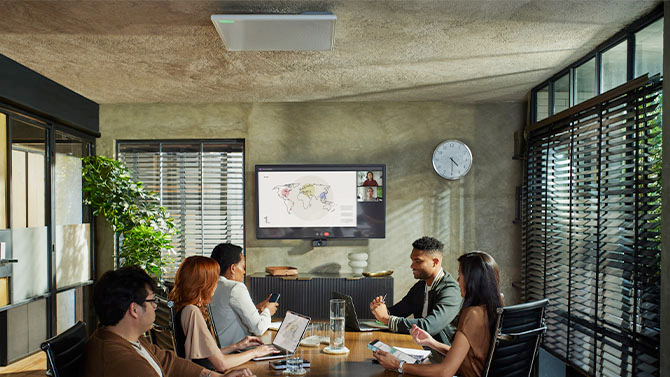By Chris Lyons, Shure
How DSP Improves Your Audio
The microphone’s job is to convert sound waves traveling through the air into an audio signal that can be transmitted, amplified, or recorded. Except in small huddle rooms, one microphone is almost never enough. Most meeting rooms require multiple microphones that need to be mixed together. The raw signals from the microphones are like singers in a choir – no matter how good they are alone, it’s how they perform together that counts.
What’s needed is some post-production that polishes and refines each individual microphone signal, and then combines them all into a balanced, harmonious mix. In the old days, this used to require a rack Definition:
Definition:
A frame for holding gear that meets an industry standard for enclosures. This specifies a 19 inch width, and a height that is some multiple of 1.75 inches. A rack frame can be open or enclosed, and has rails drilled with standardized screw holes for attaching rack equipment. full of boxes with knobs, lights, and meters that had to be painstakingly tweaked by a skilled sound engineer to work together.
Fortunately, it no longer takes an indoctrination in the dark arts of audio engineering to get the job done; now all of the important processes can be accomplished by one device called a digital Definition:
Definition:
A signal or data expressed as series of the digits 0 and 1, typically represented by values of a physical quantity such as voltage or magnetic polarization. signal processor Definition:
Definition:
A device or software program that modifies some aspect of audio or video. With audio, the term is used interchangeably with signal processor, although some use the term "effect" to describe a type of signal processor that creates an obvious change to a sound, i.e., more of a special effect. (DSP Definition:
Definition:
1. (Digital Signal Processor): An integrated circuit or device that mathematically alters sound or video signals. 2. (Digital Signal Processing): The technique of converting an analog signal into digital data, manipulating that data, then producing an analog output that reflects the changes caused by these manipulations done in the digital domain.). The DSP can be a standalone hardware appliance, or part of an application that runs on a PC – but not every DSP is suitable for workplace or college environments. The DSP for a videoconferencing Definition:
Definition:
The real-time communication of two or more parties via video and audio. application has to deal with video, call management, and other housekeeping duties; audio is just one thing on its to-do list.
What you want is a dedicated Definition:
Definition:
Designed or used to do a specific task or set of tasks. audio DSP that is designed to work with microphones, and devotes all of its attention and finesse to making speech sound as natural as it can be. Like a Swiss Army knife, an audio DSP is equipped with a full suite of processing tools to optimize audibility and intelligibility.
Audio Problems That DSP Can Fix
In a recent survey, 80% of professionals cited audio problems as the top sources of frustration with virtual meetings. Most videoconferences are plagued by the same set of chronic problems. Each of the tools or ‘processing blocks’ in your audio DSP has a specific purpose and solves one of these problems:
Problem #1: Too Loud or Too Soft
One of the most common audio problems with videoconferences is simply controlling levels. Sometimes the people on one side of the call aren’t loud enough, or sometimes they’re too loud. The solution is Automatic Gain Definition:
Definition:
The amount of amplification provided by an amplifier circuit, expressed in dB or numerically as in "3X" = "3 times". Control (AGC Definition:
Definition:
(Automatic Gain Control): Adjusts an audio system's gain for consistent levels.), which adjusts the level of each microphone channel Definition:
Definition:
1. In radio, television, citizen's band radio, and other wireless communications modes, a specific frequency for communication. 2. In mixers and video, an input or output signal path with controls. 3. In MIDI, one of 16 data paths. (or of the incoming audio from the far site) to ensure consistent volume. Like a good sound engineer, the AGC turns quiet talkers up a bit, and turns loud talkers down a bit. This is ideal for meeting rooms where the distance between the talker and the microphone varies as different people use the room.
Problem #2: We Sound Like We’re In a Barrel
Hollow sound – like you’re in a can or a barrel – can be caused by having too many open microphones at the same time. An Automatic Mixer Definition:
Definition:
A mixer primarily for voice mixing that mutes channels with no sound and also uses gain sharing for reducing feedback. takes care of that by instantly activating the nearest microphone when a talker speaks and turning off microphones that aren’t needed. In a room with eight microphones, eliminating the seven that aren’t needed makes a night-and-day difference in sound quality.
Problem #3: Echo, Echo, Echo
On a videoconference, it’s possible for the sound coming out of the loudspeaker to be picked up by a microphone and re-transmitted back to the far site, causing an annoying echo Definition:
Definition:
A repeat of an audio signal.. An Acoustic Echo Canceller (AEC Definition:
Definition:
(Acoustic Echo Cancellation): Reduces echo between multiple locations in a conference.) digitally removes the incoming far site audio from the outgoing audio to prevent this. Most video conferencing applications (like Microsoft Teams Definition:
Definition:
A computer-based, soft codec videoconferencing system from Microsoft that also includes UCC-based functions like computer content sharing. See Soft Codec, UCC., Zoom, or Skype for Business) have a single-channel AEC built-in which is best-suited for when you’re joining one of these meetings from a laptop. But for larger meeting rooms and classrooms with multiple participants and mics, good sound quality requires a DSP that dedicates a separate AEC to each microphone channel.
Problem #4: Noise Is Distracting
Most meeting rooms have some underlying background noise caused by projectors or computers, HVAC systems, building rumble Definition:
Definition:
A noise caused by mechanical vibrations being transferred to a audio transducer, such as a turntable motor., or environmental noise seeping in from outside. People in the room may not notice it, but microphones pick it up. Equalization can tune out much of the rumble and hiss Definition:
Definition:
Random noise that is inherent in electronics-based audio equipment. at the low and high ends, but electronic Noise Reduction Definition:
Definition:
A technique for reducing noise in recording or transmission systems. Single-ended noise reduction systems use filtering to isolate the noise, and expand this signal downward using downward expansion. See Expansion and Downward Expansion. Double-ended systems use symmetrical compression and expansion. See Compansion. can digitally remove noise that overlaps the speech range so it’s not audible to listeners. The effect Definition:
Definition:
A device or software program that modifies some aspect of audio or video. With audio, the term is used interchangeably with signal processor. of a DSP with good Noise Reduction can be nothing short of amazing.
Problem #5: Can’t They Hear Us?
The more noise and reverberation there is in the audio signal, the harder it is for the videoconferencing codec Definition:
Definition:
(COder-DECoder): A hardware device or software routine that digitally encodes audio or video signals for transmission or recording, then decodes them on reception or playback. (whether that’s an app on a PC or a hardware device) to provide natural back-and-forth interactivity. If audio problems aren’t solved before the signal reaches the codec, it can be difficult to interrupt the other side or for them to interrupt you. This slows down communication and causes annoying distractions.
Problem #6: Audio Not Synced With Video
Video requires more processing than audio to fit through a typical internet connection, which takes slightly more time. The audio arrives at the far site sooner than the video, so you hear someone speak before their mouth moves on the screen. An adjustable delay Definition:
Definition:
A device that outputs and input signal some time later. This can be short for echo effects, longer for matching speaker stacks, or aligning sound and video. in the DSP allows the audio feed to the videoconference to be synchronized to align with the video.
Audio DSP Hardware vs. Software
Audio conferencing DSP needs to be located wherever makes the most sense for your application. In smaller rooms, a microphone with built-in audio DSP (like the Microflex Advance MXA710 or MXA910) eliminates the need for outboard hardware and simplifies configuration. In medium to large size rooms with multiple microphones and other audio sources, audio DSP on a dedicated hardware device (like the IntelliMix P300) provides more power, flexibility, and connectivity options to interface Definition:
Definition:
A device that adds I/O capability to another device. Common would be a MIDI, audio or video interface for a computer. with hardware or software codecs. Uniquely, Shure also offers a software-based DSP solution, IntelliMix Room, that can also run on an in-room PC or videoconferencing appliance, which allows easier deployment and centralized maintenance by IT staff. No matter the form factor Definition:
Definition:
A device's general physical configuration or size, often taking into account the ratios of various measurements., high-performance audio DSP delivers natural sound that facilitates effortless communication and maximizes the value of your investment in facilities and technology.
Read the other articles highlighting the Microflex Ecosystem for AV Conferencing:
- The Microflex Ecosystem, Part 1: Conferencing Microphones
- The Microflex Ecosystem, Part 3: Conferencing Loudspeakers
- The Microflex Ecosystem, Part 4: Conferencing Software
Shure Microflex Advance array microphones combine adjustable pickup Definition:
Definition:
1. Transducer attached to a musical instrument that converts mechanical vibrations into an electrical signal for recording or amplification. 2. The part of a phonograph that translates mechanical motion from grooves into electrical signals for subsequent amplification. lobes, internal DSP, and simple configuration in a variety of ceiling, wall, or table mounting options. For a free consultation, call our trained and certified product experts at 800-356-5844. Learn more at https://www.fullcompass.com/promos/shure-microflex-conferencing-solutions.
Republished with permission from Shure Incorporated.













